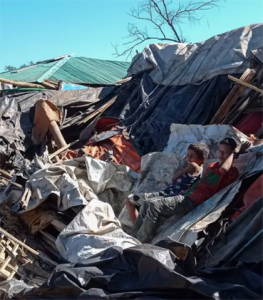Rohingya shops, hospital destroyed
Bangladeshi authorities have bulldozed over 3,000 Rohingya refugee shops over the past month sparking claims the move will cause more hardship among the persecuted Myanmar ethnic minority
Bangladesh’s deputy refugee commissioner Shamsud Douza confirmed the demolition saying the shops were “illegal” and was needed as “the number of Rohingya is increasing”.
 “And they need shelters. We are already building sheds on the premises,” he said.
“And they need shelters. We are already building sheds on the premises,” he said.
Relief groups are ensuring the Rohingya are still getting daily necessities, but that the shop owners were struggling to survive.
“Rohingya families are large and the amount of food ration given to them is decreasing. Many families used to rely on the income from the shops,” said Khin Maung, a Rohingya community leader and rights activist.
Bangladesh has received international praise for taking in Rohingyas, a stateless Muslim minority from Myanmar who fled after a military crackdown in 2017 that prompted an UN genocide investigation.
Currently, around 850,000 members of the Rohingya community live in various displacement camps in Bangladesh.
Amnesty International said that the demolition could leave the Rohingya refugees more vulnerable.
“Demolition of shops and closure of community-led schools … aggravate tension and frustration,” a spokesperson said.
He urged authorities to “protect the rights and dignity of the Rohingya refugees by involving them in the decisions including their right to earn a living”.
In November 2021, the Bangladesh government began relocating hundreds of Rohingya refugees to an island in the Bay of Bengal called Bhashan Char Island.
The move came despite concerns from rights groups over the conditions on the vulnerable low-lying island and that no refugees should be sent forcibly.
The shop demolition came after a fire ripped through a COVID-19 hospital for refugees at the Cox’s Bazar camp.
IOM said that no-one was hurt at the health facility but parts of the hospital were badly damaged.
The camp hosts many of the million Rohingya refugees that have fled violence and persecution in Myanmar in successive waves of displacement since the early 1990s.
At the peak of the latest crisis, in 2017, thousands were crossing into Bangladesh daily.
Since then, the Kutupalong refugee settlement has grown to become the largest of its kind in the world, with more than 600,000 people living in an area of just 13 square kilometres, stretching infrastructure and services to their limits.
The 2021 Joint Response Plan (JRP) for the Rohingya Humanitarian Crisis targets almost 1.4 million people in need.
The $943 million plan seeks to meet the needs of 884,000 Rohingya refugees and 472,000 Bangladeshis in the host communities of Cox’s Bazar.












